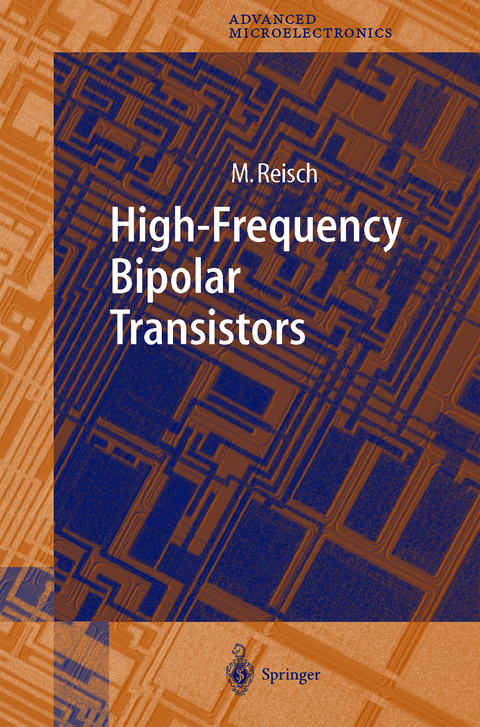
High-Frequency Bipolar Transistors
Springer Berlin (Verlag)
978-3-540-67702-4 (ISBN)
Michael Reisch wurde 1957 im oberschwäbischen Bad Waldsee geboren. Er studierte Physik an der TU München und promovierte am Institut für Physikalische Elektronik der TU Wien. Er war von 1983 bis 1991 für die Siemens AG (Zentrale Forschung und Entwicklung) in München tätig. Seit 1991 ist er als Professor an der FH Kempten vor allem für die Lehrgebiete Werkstoffe der Elektrotechnik sowie Elektronische Bauelemente zuständig. Sein berufliches Hauptinteresse gilt der Physik und Modellierung elektronischer Bauelemente - in seiner Freizeit ist er am liebsten mit Tourenski oder Mountainbike in den Bergen unterwegs.
1. An Introductory Survey.- 1.1 History.- 1.2 Devices, Circuits, Compact Models.- 1.3 Semiconductors.- 1.4 PN Junctions.- 1.5 Bipolar Transistor Principles.- 1.6 Elementary Large-Signal Models.- 1.7 Elementary Small-Signal Models.- 1.8 Noise Modeling.- 1.9 Orders of Magnitude.- 1.10 References.- 2. Semiconductor Physics Required for Bipolar-Transistor Modeling.- 2.1 Band Structure.- 2.2 Thermal Equilibrium.- 2.3 The Boltzmann Equation.- 2.4 The Drift-Diffusion Approximation.- 2.5 Hydrodynamic Model.- 2.6 Generation and Recombination.- 2.7 Heavily Doped Semiconductors.- 2.8 Silicon Device Modeling in the Drift-Diffusion Approximation.- 2.9 References.- 3. Physics and Modeling of Bipolar Junction Transistors.- 3.1 The Regional Approach.- 3.2 Transfer Current, Early Effect.- 3.3 Emitter-Base Diode, Current Gain.- 3.4 Base-Collector Diode, Breakdown.- 3.5 Charge Storage, Transit Time.- 3.6 Series Resistances.- 3.7 High-Level Injection.- 3.8 The Gummel-Poon Model.- 3.9 Small-Signal Description.- 3.10 Figures of Merit.- 3.11 Temperature Dependences, Self-Heating.- 3.12 Parameter Extraction - DC Measurements.- 3.13 Parameter Extraction - AC Measurements.- 3.14 The VBIC Model.- 3.15 The HICUM Model.- 3.16 The MEXTRAM Model.- 3.17 References.- 4. Physics and Modeling of Heterojunction Bipolar Transistors.- 4.1 Heterojunctions.- 4.2 Heterojunction Bipolar Transistors.- 4.3 Silicon-Based Semiconductor Hctorostructures.- 4.4 SiGe HBTs.- 4.5 Compound Semiconductor HBTs.- 4.6 References.- 5. Noise Modeling.- 5.1 Noise in Semiconductors.- 5.2 Transport Theory of Noise.- 5.3 Noise of pn Junctions.- 5.4 Noise Generated by the Transfer Current.- 5.5 High-Frequency Noise Equivalent Circuit.- 5.6 Noise Figure.- 5.7 Low-Frequency Noise.- 5.8 References.- 6. Basic CircuitConfigurations.- 6.1 Common-Emitter Configuration.- 6.2 Common-Collector Configuration.- 6.3 Common-Base Configuration.- 6.4 The Diode-Connected Bipolar Transistor.- 6.5 Current Sources and Active Loads.- 6.6 Differential Amplifiers.- 6.7 Analog Multipliers.- 6.8 Two-Transistor Amplifier Stages.- 6.9 Bandgap References.- 6.10 Digital Circuits.- 6.11 References.- 7. Process Integration.- 7.1 Fabrication of Integrated npn Transistors.- 7.2 Passive Components.- 7.3 PNP Transistors.- 7.4 Reliability.- 7.5 References.- 8. Applications.- 8.1 Emitter-Coupled Logic.- 8.2 High-Speed Optical Transmission Systems.- 8.3 RF Microelectronics.- 8.4 BiCMOS.- 8.5 References.- A. Linear and Nonlinear Response.- A.1 Linear Response.- A.1.1 Step Response, Elmore Delay.- A.2 Nonlinear Systems Without Memory.- A.2.1 Harmonic Distortion, Gain Compression.- A.2.2 Intermodulation Distortion.- A.3 Nonlinear Systems with Memory.- A.3.1 Volterra Series.- A.4 References.- B. Linear Two-Ports, s-Parameters.- B.1 Indefinite Admittance Matrix.- B.2 Terminated Two-Ports.- B.2.1 Input and Output Impedance.- B.2.2 Voltage and Current Gain.- B.2.3 Power Gain.- B.2.4 Stability.- B.2.5 Incident and Reflected Power.- B.3 S-Parameters.- B.3.1 Relations between s-Parameters and Two-Port Parameters.- B.3.2 Matching and Power Gain.- B.4 References.- C. PN Junctions: Details.- C.1 Boundary Conditions at PN Junctions.- C.2 Epitaxial Diode.- C.3 Minority-Carrier Transport in Heavily Doped Emitter Regions.- C.4 High-Frequency Diode Admittance.- C.5 References.- D. Bipolar Transistor: Details.- D.1 Drift Transistor.- D.1.1 Electron Transport Through the Base Region.- D.1.3 Excess Phase.- D.1.4 Collector Transit Time.- D.1.5 Small-Signal Analysis.- D.2 Quasi-Thrce-Dimensional Computations of the Base Resistance.- D.3Generation of Model Parameters from Layout Data.- D.4 Generalization of the Gummol Transfer Current Relation to Arbitrary Geometries.- D.5 Definition of Series Resistances Within the Integral Charge Control Relation.- D.6 Multiplication Factor.- D.7 References.- E. Noise: Details.- E.1 Some Statistics.- E.1.1 Stochastic Variables, Correlation.- E.1.2 Ensemble Average, Distribution Function.- E.1.3 Spectral Density.- E.1.4 Carson Theorem, Shot Noise.- E.2 Velocity Fluctuations and Diffusion.- E.3 Thermodynamics and Noise.- E.4 Generation-Recombination Noise.- E.5 McWorther Model of 1/f Noise.- E.6 Short-Base Diode with Metal Contact.- E.7 Short-Base Diode with Polysilicon Contact.- E.8 Equivalent-Circuit Representation of Transfer Current Noise.- E.9 References.- F. Overtemperature Developed During Electrostatic Discharges.- F.1 Thermal Conductivity.- F.2 Transient Overtemperature During a Short Pulse.- F.3 References.
| Erscheint lt. Verlag | 5.3.2003 |
|---|---|
| Reihe/Serie | Springer Series in Advanced Microelectronics |
| Zusatzinfo | XX, 658 p. |
| Verlagsort | Berlin |
| Sprache | englisch |
| Maße | 155 x 235 mm |
| Gewicht | 1080 g |
| Themenwelt | Technik ► Elektrotechnik / Energietechnik |
| Schlagworte | bipolar junction transistor • Bipolartransistor • CMOS • drift transistor • Heterojunction Bipolar Transistor • Hochfrequenz (HF) • Integrated circuit • Logic • Modulation • Physics • semiconductor • Transistor |
| ISBN-10 | 3-540-67702-X / 354067702X |
| ISBN-13 | 978-3-540-67702-4 / 9783540677024 |
| Zustand | Neuware |
| Haben Sie eine Frage zum Produkt? |
aus dem Bereich



